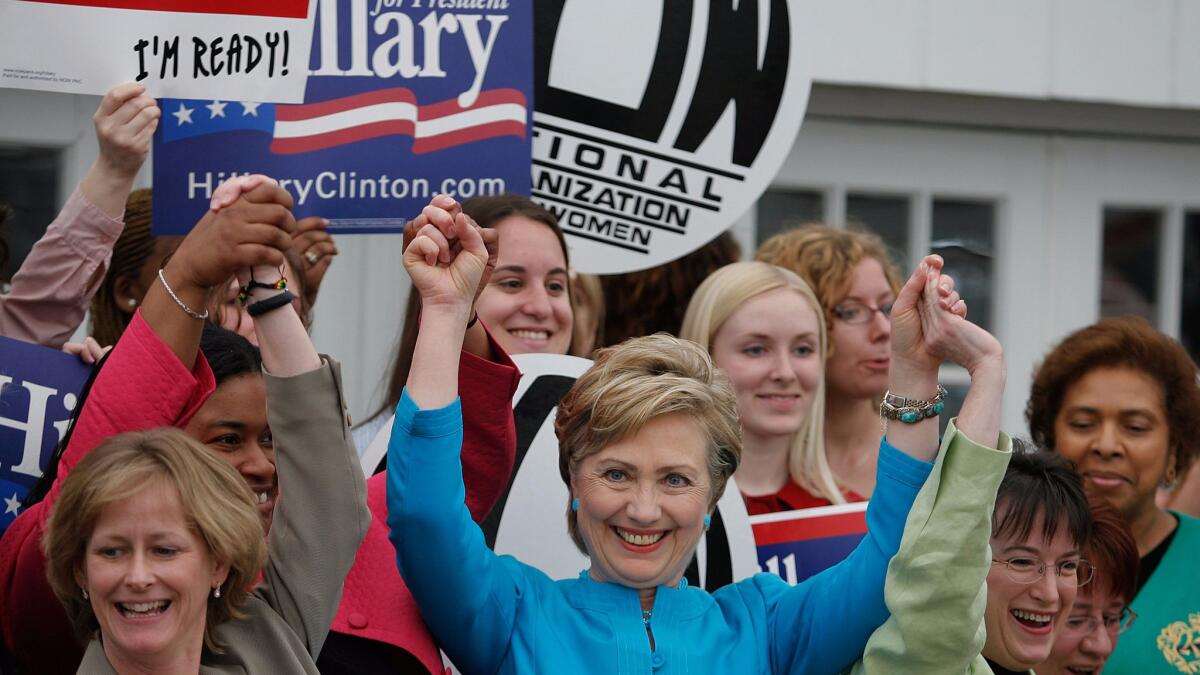NOW, turning 50, hails feminist gains but says the ‘battle goes on’

- Share via
Reporting from NEW YORK — Fifty years ago, when a small group of activists founded the National Organization for Women, the immediate issue that motivated them was sex discrimination in employment. They were irate that the Equal Employment Opportunity Commission was refusing to ban gender-specific “help wanted” ads.
Typical were ads seeking a “well-groomed gal” for a job as a receptionist.
Flash forward to today: Women make up close to 50% of enrollment in U.S. medical and law schools. One-third of federal judges are women, compared with just a handful in the 1960s. The U.S military is opening all combat jobs to women.
At NOW and elsewhere in the diverse ranks of the feminist movement, there’s deep pride in these changes, but also a consensus that the 50th anniversary — to be celebrated June 23 — is not an occasion to declare victory.
See more of our top stories on Facebook »
“The battle goes on,” said Eleanor Smeal, a former president of NOW who heads the Feminist Majority Foundation. “So many of the things we fought for have been achieved, but we still do not have full equality.”
Among the issues viewed as unfinished business: a wage gap that favors men over women, the persistent scourge of sexual assault and domestic violence, and the push in many states to reduce access to legal abortion.
Once virtually alone as a national, multi-issue feminist group, NOW shares the activist stage today with a multitude of other players — ranging from youthful online organizers to groups focused on specific issues such as abortion rights, campus rape and workplace equity. NOW’s membership and revenue are down from its peak years, and some younger feminists wonder if it is losing some relevance.
The situation was very different back in 1966. NOW’s founding was a pivotal moment in the rebuilding of a vibrant feminist movement in the U.S. after a period of relative dormancy in the 1940s and ’50s.
“The momentum of the feminist movement that won suffrage and expanded women’s rights in the early 20th century had waned,” says NOW in its own history. “A negative media blitz proclaimed the death of feminism and celebrated the happy, suburban housewife.”
The so-called second wave of U.S. feminism gained momentum in part because of “The Feminine Mystique,” Betty Friedan’s 1963 book that gave a voice to women frustrated by the gender inequities of the status quo. Friedan was among the co-founders of NOW and was chosen as its first president at an organizing conference in October 1966.
She also wrote the Statement of Purpose adopted by NOW at that conference.
The statement vowed “to break through the silken curtain of prejudice and discrimination against women in government, industry, the professions, the churches, the political parties, the judiciary, the labor unions, in education, science, medicine, law, religion and every other field of importance in American society.”
Fifty years later, only patches of that silken curtain remain, and Hillary Clinton will have a chance this fall to add the ultimate breakthrough by becoming the first woman elected president. NOW has eagerly endorsed her, while depicting her Republican rival, Donald Trump, as “a boorish, babbling bigot who disrespects women.”
Trump prides himself on an ability to draw large crowds to his rallies; for many years, that was a hallmark for NOW as well. An estimated 100,000 people turned out for a 1977 march in Washington in favor of the Equal Rights Amendment to the U.S. Constitution, which ultimately failed to garner support from enough states to win ratification. Far larger crowds assembled for abortion rights marches in 1989 and 1992.

In subsequent years, there have been only a few mass mobilizations of feminists. NOW’s president, Terry O’Neill, says the drop-off in revenues and dues-paying membership resulted in part from a drop in engagement by activists who, after a 1992 Supreme Court ruling, perceived less of a threat to abortion rights.
O’Neill declined to provide financial details, but said NOW’s national headquarters in Washington is down to a staff of 11, about a third of its size 25 years ago.
While younger feminists appreciate NOW’s legacy, some also question its tactical skills and its demographics.
Generational rifts have surfaced in the presidential campaign, as many young women backed Bernie Sanders in the Democratic race rather than Clinton. When renowned feminist Gloria Steinem suggested that Sanders’ young female supporters were doing so in order to meet young men, there was enough outrage to prompt an apology from Steinem.
Jessica Valenti, a New York-based author who founded the popular blog Feministing in 2004, said younger feminists, acting individually or in small groups, have become adept at online organizing and activism.
“That doesn’t mean the big national organizations are unnecessary,” said Valenti, 37. “I would love to see them continue to get funding and do work, but my hope is that they take cues from younger organizers and that their work evolves with us.”
Crary writes for the Associated Press.
More to Read
Sign up for Essential California
The most important California stories and recommendations in your inbox every morning.
You may occasionally receive promotional content from the Los Angeles Times.













